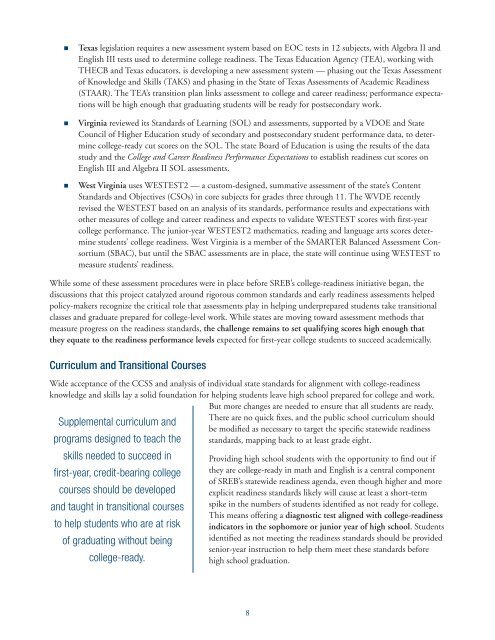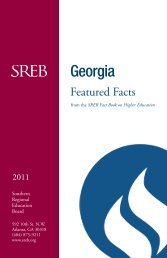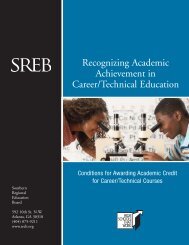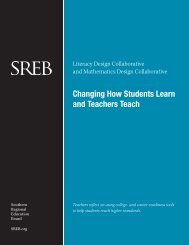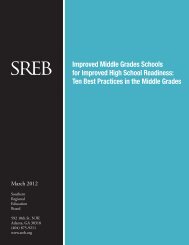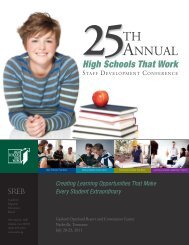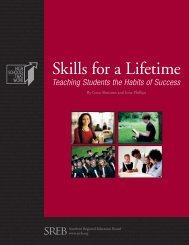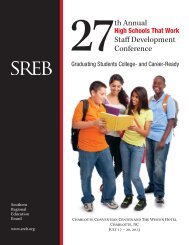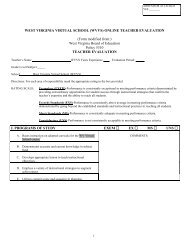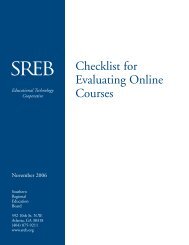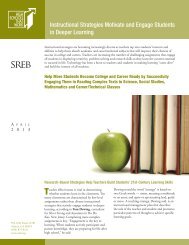Final Progress Reports - Southern Regional Education Board
Final Progress Reports - Southern Regional Education Board
Final Progress Reports - Southern Regional Education Board
Create successful ePaper yourself
Turn your PDF publications into a flip-book with our unique Google optimized e-Paper software.
Texas legislation requires a new assessment system based on EOC tests in 12 subjects, with Algebra II and<br />
English III tests used to determine college readiness. The Texas <strong>Education</strong> Agency (TEA), working with<br />
THECB and Texas educators, is developing a new assessment system — phasing out the Texas Assessment<br />
of Knowledge and Skills (TAKS) and phasing in the State of Texas Assessments of Academic Readiness<br />
(STAAR). The TEA’s transition plan links assessment to college and career readiness; performance expectations<br />
will be high enough that graduating students will be ready for postsecondary work.<br />
Virginia reviewed its Standards of Learning (SOL) and assessments, supported by a VDOE and State<br />
Council of Higher <strong>Education</strong> study of secondary and postsecondary student performance data, to determine<br />
college-ready cut scores on the SOL. The state <strong>Board</strong> of <strong>Education</strong> is using the results of the data<br />
study and the College and Career Readiness Performance Expectations to establish readiness cut scores on<br />
English III and Algebra II SOL assessments.<br />
West Virginia uses WESTEST2 — a custom-designed, summative assessment of the state’s Content<br />
Standards and Objectives (CSOs) in core subjects for grades three through 11. The WVDE recently<br />
revised the WESTEST based on an analysis of its standards, performance results and expectations with<br />
other measures of college and career readiness and expects to validate WESTEST scores with first-year<br />
college performance. The junior-year WESTEST2 mathematics, reading and language arts scores determine<br />
students’ college readiness. West Virginia is a member of the SMARTER Balanced Assessment Consortium<br />
(SBAC), but until the SBAC assessments are in place, the state will continue using WESTEST to<br />
measure students’ readiness.<br />
While some of these assessment procedures were in place before SREB’s college-readiness initiative began, the<br />
discussions that this project catalyzed around rigorous common standards and early readiness assessments helped<br />
policy-makers recognize the critical role that assessments play in helping underprepared students take transitional<br />
classes and graduate prepared for college-level work. While states are moving toward assessment methods that<br />
measure progress on the readiness standards, the challenge remains to set qualifying scores high enough that<br />
they equate to the readiness performance levels expected for first-year college students to succeed academically.<br />
Curriculum and Transitional Courses<br />
Wide acceptance of the CCSS and analysis of individual state standards for alignment with college-readiness<br />
knowledge and skills lay a solid foundation for helping students leave high school prepared for college and work.<br />
But more changes are needed to ensure that all students are ready.<br />
There are no quick fixes, and the public school curriculum should<br />
Supplemental curriculum and<br />
be modified as necessary to target the specific statewide readiness<br />
standards, mapping back to at least grade eight.<br />
programs designed to teach the<br />
skills needed to succeed in<br />
first-year, credit-bearing college<br />
courses should be developed<br />
and taught in transitional courses<br />
to help students who are at risk<br />
of graduating without being<br />
college-ready.<br />
Providing high school students with the opportunity to find out if<br />
they are college-ready in math and English is a central component<br />
of SREB’s statewide readiness agenda, even though higher and more<br />
explicit readiness standards likely will cause at least a short-term<br />
spike in the numbers of students identified as not ready for college.<br />
This means offering a diagnostic test aligned with college-readiness<br />
indicators in the sophomore or junior year of high school. Students<br />
identified as not meeting the readiness standards should be provided<br />
senior-year instruction to help them meet these standards before<br />
high school graduation.<br />
8


